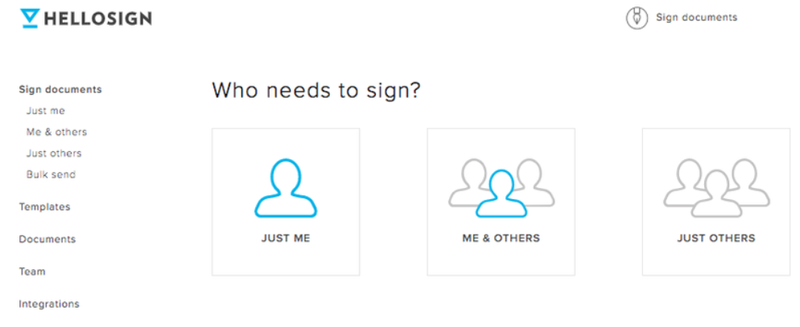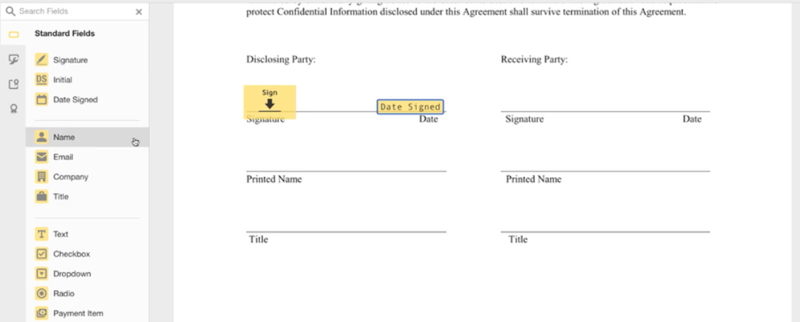How To Create Electronic Signature Word
We may receive compensation from partners and advertisers whose products appear here. Compensation may impact where products are placed on our site, but editorial opinions, scores, and reviews are independent from, and never influenced by, any advertiser or partner.
If there's one thing every business owner hates, it's paperwork. Every business has to handle a huge amount of it, and organizing it is a time-consuming and expensive hassle. But it's unavoidable.
Electronic signatures present an opportunity to improve your document management efficiency. Signing documents is time-consuming and involves a lot of back-and-forth. It's difficult to keep track of whether documents are signed or unsigned, who needs them and when, and so on.
That's where e-signatures come in. E-signatures make signing documents easy, and they improve document management in the process. This guide will describe what they are and how you can implement them in your business.
Overview: What's an electronic signature?
An electronic signature, or e-signature, describes the process of signing your name to a digital document. Usually, this is done for digital documents that require the signer's agreement, such as a contract.
An electronic signature eliminates the need to physically print out the document, sign your name with ink (also known as a "wet signature"), scan it, and send it back to the original senders.
This saves a lot of time. Courts have ruled e-signatures are legally enforceable. It doesn't even have to be an actual signature — the signer can type their name or check a box agreeing to the terms, for example.
Electronic signature vs. digital signature: What's the difference?
The terms e-signature and digital signature often are used interchangeably, but they're different. A digital signature is a much more involved, technical process than an e-signature. Its purpose is to ensure that a document hasn't been altered or accessed by an unauthorized user.
A digital signature uses layers of encryption to verify the authenticity and the integrity of the document, creating a "fingerprint" using digital signature certificates and keys.
Benefits of electronic signatures
Online signatures help businesses operate more efficiently in several ways.
1. They speed up the process
Collecting signatures is tedious if you don't do it electronically. To get a signature, you have to ship the document or have the recipient print it out. After they sign the document, they have to get it back to you, which means physically mailing it back or scanning and emailing it.
These are time-consuming processes. They not only prevent a document from getting back to you in a timely manner, but waste a lot of time for both the signer and signee. An e-signature takes seconds, with no downside.
2. They're more secure
While e-signatures don't have the level of security that digital signatures do, they still offer better security thanks to the audit trail indicating who signed the document and when. You won't get that verifiability with a document printed on paper, signed, scanned, and emailed back to you.
3. They're cheaper
When you're spending a ton of time getting contracts signed the old-fashioned way, it costs your business money.
The opportunity costs may be tremendous — you may spend hours handling documents requiring signatures each week, time you could spend plotting out and executing a long-term strategy rather than running around putting out fires.
4. They make your business more organized
With documents floating about in email, things are bound to go missing. By switching to e-signatures, your business document management will improve, and your business will be more organized as a whole. With a more organized business, you and your team operate with greater efficiency, boosting your bottom line.

HelloSign's dashboard makes it easy to start the e-signature creation process. Source: HelloSign.
Are electronic signatures legal?
The answer is yes, thanks to the Electronic Signatures in Global and National Commerce Act (ESIGN), in effect since 2000. Many state laws govern the use of e-signatures, so check with a lawyer to understand how that affects your company, but federal law stipulates how interstate commerce must treat e-signatures.
The ESIGN Act (sometimes stylized as the E-Sign act) states a contract or signature "may not be denied legal effect, validity, or enforceability solely because it is in electronic form."
The E-Sign Act defines an electronic signature as "an electronic sound, symbol, or process attached to or logically associated with a contract or other record and executed or adopted by a person with the intent to sign the record" — meaning you don't need an actual signature.
Instead, you could ask the signer to type their name or check a box indicating agreement. As long as you can demonstrate the signer took an action indicating agreement with the document, it carries legal weight.
Electronic signatures carry some risk. If you don't record the entire signature process by tracking how each user interacts with the agreements and affixes their signature, there's a chance you have introduced enough doubt in the signature's authenticity for a court to throw it out.
That's why digital signatures give your e-signatures added weight.
Don't worry too much about this. E-signatures have continued to grow in acceptance in legal circles since they were introduced, and you're unlikely to run into legal problems because of an electronic signature.
How do electronic signatures work?
Unless you're a tech wizard or software developer, you'd be unwise to create your own electronic signatures. Instead, choose from several electronic signature software solutions to do the work for you.
Adobe Acrobat, Microsoft Edge, and DocuSign are a few of the big names in electronic signatures, but other platforms allow you to create a free electronic signature.
These solutions let you create an electronic form in a document with just a few clicks. If you're the signer, the process is even easier — you receive a document and sign it by clicking on the signature field, whether typing your name or checking a box.

DocuSign allows you to sign documents by simply clicking on the highlighted Sign icon in the document. Source: DocuSign.
Start using e-signatures ASAP
Using e-signatures is one of the document management best practices, so if you aren't using them, it's time to start. Take a close look at your current electronic filing system and ask what processes need changing to incorporate e-signatures.
For example, if your current standards describe a complicated process that involves sending documents to signers, verifying them with a supervisor once they are returned, and so on, replace all those steps with an e-signature software platform to sign documents online.
It may not seem like much, but this simple step should save you and your employees lots of time.
The Motley Fool has a Disclosure Policy. The Author and/or The Motley Fool may have an interest in companies mentioned.
How To Create Electronic Signature Word
Source: https://www.fool.com/the-blueprint/electronic-signature/
Posted by: byrdcasent.blogspot.com

0 Response to "How To Create Electronic Signature Word"
Post a Comment